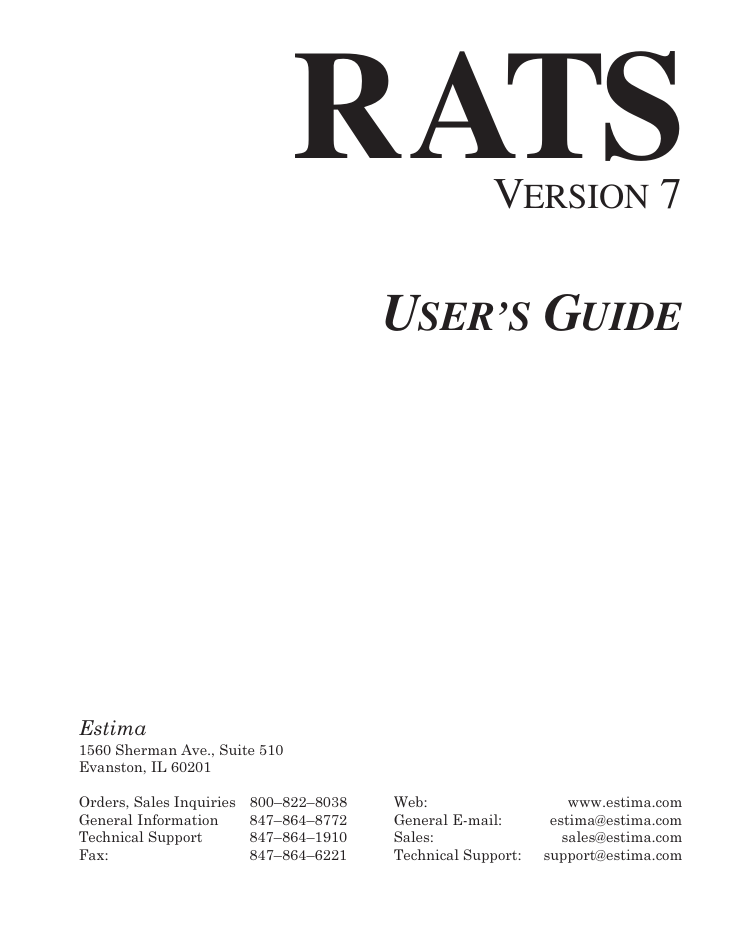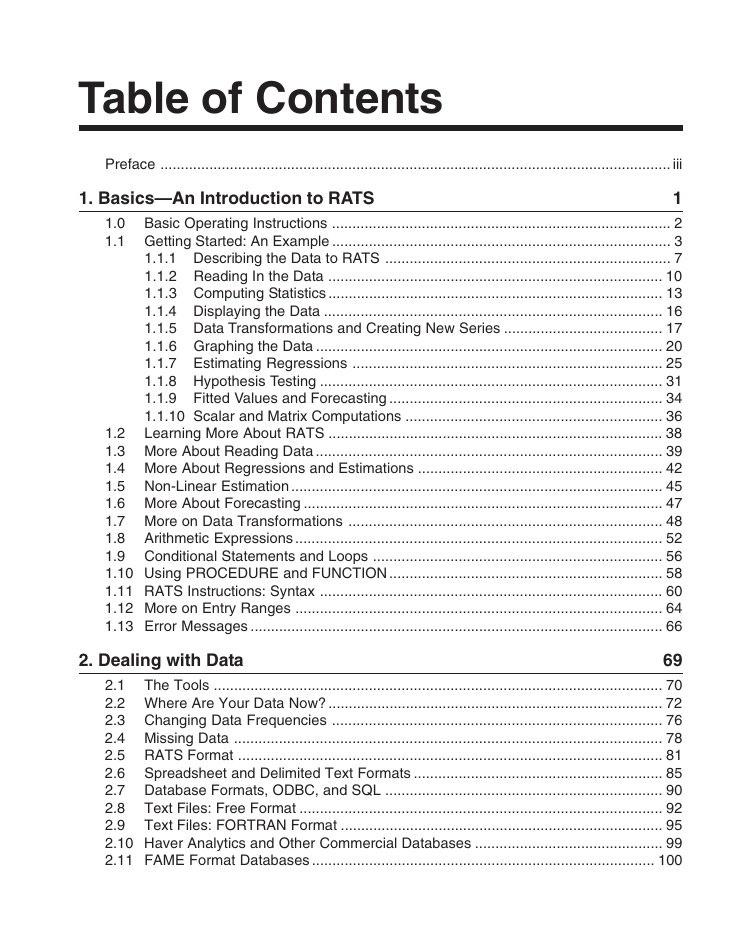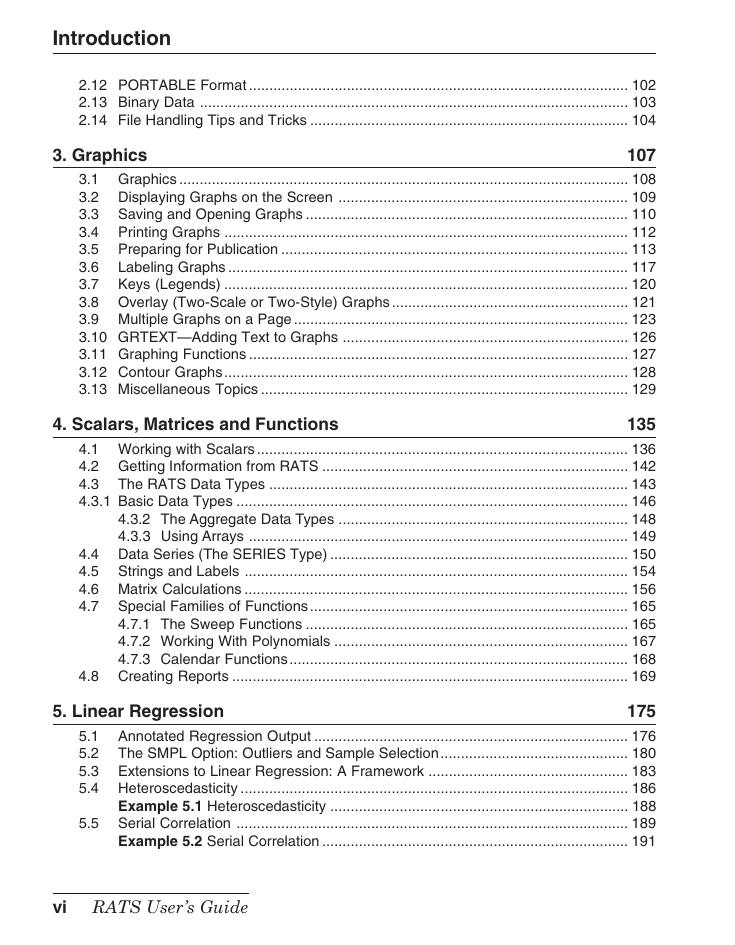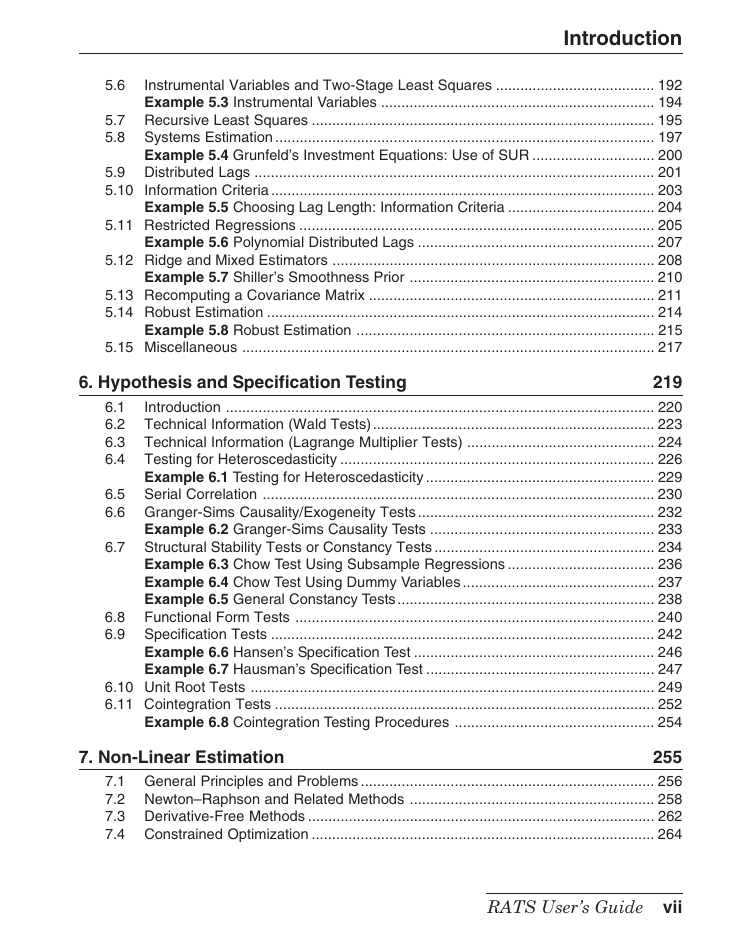RATS
VERSION 7
USER’S GUIDE
Estima
1560 Sherman Ave., Suite 510
Evanston, IL 60201
Orders, Sales Inquiries 800–822–8038
847–864–8772
General Information
847–864–1910
Technical Support
Fax:
847–864–6221
Web:
General E-mail:
Sales:
Technical Support:
www.estima.com
estima@estima.com
sales@estima.com
support@estima.com
�
© 2007 by Estima. All Rights Reserved.
No part of this book may be reproduced or transmitted in any form or by any means
without the prior written permission of the copyright holder.
Estima
1560 Sherman Ave., Suite 510
Evanston, IL 60201
Published in the United States of America
First Printing: August 2007
�
Preface
Welcome to Version 7 of RATS. In the three years since version 6 was released, we’ve
continued our two-pronged approach of making the power and sophistication of RATS
available to a wider range of users through the addition and improvement of “wiz-
ards”, while simultaneously increasing that power and sophistication for our existing
user base.
Five years ago, we began a project of implementing (all) the worked examples from a
wide range of textbooks. These have included everything from introductory econo-
metrics and time series books to graduate level books covering almost the full range
of modern econometrics. More recently, we’ve added replication files for a number of
important published papers. Our experience with this (over 1000 running examples)
has led to great improvements in the program. We’re grateful to Kit Baum, Tim
Bollerslev, Chris Brooks, Kai Carstensen, Richard Davis, Steve De Lurgio, Frank
Diebold, Jordi Gali, Bill Greene, Bruce Hansen, Jim Hamilton, Fumio Hayashi, Timo
Teräsvirta, Ruey Tsay, Harald Uhlig, Marno Verbeek, Mark Watson and Jeff Woold-
ridge for their help in providing data and programs, and checking results.
The new documentation includes more and better examples. The chapters of the
User’s Guide which have seen the most work are 6 (Hypothesis Tests), 10 (Vector
Autoregressions), 12 (Special Models) and 13 (Simulations and Bootstrapping).
Chapter 13, in particular, has been almost entirely rewritten to bring it up-to-date
with the fast-moving branch of computationally-intensive statistics.
Thanks to all those in the RATS community who have contributed ideas, suggestions
and procedures for others to use. Special thanks go to Walter Enders for writing the
popular e-book, The RATS Programming Language, Rob Trevor for setting up and
maintaining the RATS discussion list, and to Paco Goerlich and Norman Morin for
the numerous procedures they’ve written. Jonathan Dennis from the University of
Copenhagen (the principal programmer of the CATS program) had a major role in
designing and refining the REPORT and DBOX instructions. Chris Sims, as always,
had a special role in influencing the direction of our coverage of time series. John
Geweke has provided very helpful discussions on Bayesian methods.
Tom Maycock has kept the reference manual up-to-date through six interim versions
between 6.0 and 7.0, while handling the bulk of the technical support questions and
maintaining our extensive web site. To say that he’s invaluable would be an under-
statement.
I would also like to thank my wife Robin and daughters Jessica and Sarah for their
patience, and Jessica, in particular, for her work on the layout of Macintosh dialog
boxes.
Thomas A. Doan
August 2007
�
�
Table of Contents
Preface ............................................................................................................................. iii
1. Basics—An Introduction to RATS
1
1.0 Basic Operating Instructions ................................................................................... 2
1.1 Getting Started: An Example ................................................................................... 3
1.1.1 Describing the Data to RATS ...................................................................... 7
1.1.2 Reading In the Data .................................................................................. 10
1.1.3 Computing Statistics .................................................................................. 13
1.1.4 Displaying the Data ................................................................................... 16
1.1.5 Data Transformations and Creating New Series ....................................... 17
1.1.6 Graphing the Data ..................................................................................... 20
1.1.7 Estimating Regressions ............................................................................ 25
1.1.8 Hypothesis Testing .................................................................................... 31
1.1.9 Fitted Values and Forecasting ................................................................... 34
1.1.10 Scalar and Matrix Computations ............................................................... 36
1.2
Learning More About RATS .................................................................................. 38
1.3 More About Reading Data ..................................................................................... 39
1.4 More About Regressions and Estimations ............................................................ 42
1.5 Non-Linear Estimation ........................................................................................... 45
1.6 More About Forecasting ........................................................................................ 47
1.7 More on Data Transformations ............................................................................. 48
1.8 Arithmetic Expressions .......................................................................................... 52
1.9 Conditional Statements and Loops ....................................................................... 56
1.10 Using PROCEDURE and FUNCTION ................................................................... 58
1.11 RATS Instructions: Syntax .................................................................................... 60
1.12 More on Entry Ranges .......................................................................................... 64
1.13 Error Messages ..................................................................................................... 66
2. Dealing with Data
69
2.1
The Tools .............................................................................................................. 70
2.2 Where Are Your Data Now? .................................................................................. 72
2.3 Changing Data Frequencies ................................................................................. 76
2.4 Missing Data ......................................................................................................... 78
2.5 RATS Format ........................................................................................................ 81
2.6 Spreadsheet and Delimited Text Formats ............................................................. 85
2.7 Database Formats, ODBC, and SQL .................................................................... 90
Text Files: Free Format ......................................................................................... 92
2.8
2.9
Text Files: FORTRAN Format ............................................................................... 95
2.10 Haver Analytics and Other Commercial Databases .............................................. 99
2.11 FAME Format Databases .................................................................................... 100
�
Introduction
2.12 PORTABLE Format ............................................................................................. 102
2.13 Binary Data ......................................................................................................... 103
2.14 File Handling Tips and Tricks .............................................................................. 104
3. Graphics
107
3.1 Graphics .............................................................................................................. 108
3.2 Displaying Graphs on the Screen ....................................................................... 109
3.3 Saving and Opening Graphs ............................................................................... 110
3.4 Printing Graphs ................................................................................................... 112
3.5 Preparing for Publication ..................................................................................... 113
3.6
Labeling Graphs .................................................................................................. 117
3.7 Keys (Legends) ................................................................................................... 120
3.8 Overlay (Two-Scale or Two-Style) Graphs .......................................................... 121
3.9 Multiple Graphs on a Page .................................................................................. 123
3.10 GRTEXT—Adding Text to Graphs ...................................................................... 126
3.11 Graphing Functions ............................................................................................. 127
3.12 Contour Graphs................................................................................................... 128
3.13 Miscellaneous Topics .......................................................................................... 129
4. Scalars, Matrices and Functions
135
4.1 Working with Scalars ........................................................................................... 136
4.2 Getting Information from RATS ........................................................................... 142
4.3
The RATS Data Types ........................................................................................ 143
4.3.1 Basic Data Types ................................................................................................ 146
4.3.2 The Aggregate Data Types ....................................................................... 148
4.3.3 Using Arrays ............................................................................................. 149
4.4 Data Series (The SERIES Type) ......................................................................... 150
4.5 Strings and Labels .............................................................................................. 154
4.6 Matrix Calculations .............................................................................................. 156
4.7 Special Families of Functions.............................................................................. 165
4.7.1 The Sweep Functions ............................................................................... 165
4.7.2 Working With Polynomials ........................................................................ 167
4.7.3 Calendar Functions................................................................................... 168
4.8 Creating Reports ................................................................................................. 169
5. Linear Regression
175
5.1 Annotated Regression Output ............................................................................. 176
5.2
The SMPL Option: Outliers and Sample Selection.............................................. 180
5.3 Extensions to Linear Regression: A Framework ................................................. 183
5.4 Heteroscedasticity ............................................................................................... 186
Example 5.1 Heteroscedasticity ......................................................................... 188
5.5 Serial Correlation ................................................................................................ 189
Example 5.2 Serial Correlation ........................................................................... 191
vi RATS User’s Guide
�
Introduction
5.6
Instrumental Variables and Two-Stage Least Squares ....................................... 192
Example 5.3 Instrumental Variables ................................................................... 194
5.7 Recursive Least Squares .................................................................................... 195
5.8 Systems Estimation ............................................................................................. 197
Example 5.4 Grunfeld’s Investment Equations: Use of SUR .............................. 200
5.9 Distributed Lags .................................................................................................. 201
5.10 Information Criteria .............................................................................................. 203
Example 5.5 Choosing Lag Length: Information Criteria .................................... 204
5.11 Restricted Regressions ....................................................................................... 205
Example 5.6 Polynomial Distributed Lags .......................................................... 207
5.12 Ridge and Mixed Estimators ............................................................................... 208
Example 5.7 Shiller’s Smoothness Prior ............................................................ 210
5.13 Recomputing a Covariance Matrix ...................................................................... 211
5.14 Robust Estimation ............................................................................................... 214
Example 5.8 Robust Estimation ......................................................................... 215
5.15 Miscellaneous ..................................................................................................... 217
6. Hypothesis and Specification Testing
6.1
6.2
6.3
6.4
219
Introduction ......................................................................................................... 220
Technical Information (Wald Tests)..................................................................... 223
Technical Information (Lagrange Multiplier Tests) .............................................. 224
Testing for Heteroscedasticity ............................................................................. 226
Example 6.1 Testing for Heteroscedasticity ........................................................ 229
6.5 Serial Correlation ................................................................................................ 230
6.6 Granger-Sims Causality/Exogeneity Tests .......................................................... 232
Example 6.2 Granger-Sims Causality Tests ....................................................... 233
6.7 Structural Stability Tests or Constancy Tests ...................................................... 234
Example 6.3 Chow Test Using Subsample Regressions .................................... 236
Example 6.4 Chow Test Using Dummy Variables ............................................... 237
Example 6.5 General Constancy Tests............................................................... 238
6.8
Functional Form Tests ........................................................................................ 240
6.9 Specification Tests .............................................................................................. 242
Example 6.6 Hansen’s Specification Test ........................................................... 246
Example 6.7 Hausman’s Specification Test ........................................................ 247
6.10 Unit Root Tests ................................................................................................... 249
6.11 Cointegration Tests ............................................................................................. 252
Example 6.8 Cointegration Testing Procedures ................................................. 254
7. Non-Linear Estimation
255
7.1 General Principles and Problems ........................................................................ 256
7.2 Newton–Raphson and Related Methods ............................................................ 258
7.3 Derivative-Free Methods ..................................................................................... 262
7.4 Constrained Optimization .................................................................................... 264
RATS User’s Guide
vii
�
Introduction
7.5 Covariance Matrices ........................................................................................... 266
7.6 Setting Up Your Model: NONLIN and FRML ....................................................... 270
7.7 Non-Linear Least Squares/Two-Stage Least Squares ........................................ 276
Example 7.1 Non-Linear Least Squares............................................................. 278
7.8 Method of Moments Estimators (Univariate) ....................................................... 279
Example 7.2 Generalized Instrumental Variables ............................................... 281
7.9 Non-Linear Systems Estimation .......................................................................... 282
Example 7.3 Non-Linear Systems Estimation .................................................... 285
7.10 More General Maximization ................................................................................ 286
7.11 Using FUNCTION ............................................................................................... 289
Example 7.4 Using FUNCTION .......................................................................... 291
7.12 Using FIND .......................................................................................................... 293
7.13 Troubleshooting .................................................................................................. 294
8. Introduction to Forecasting
297
8.1
Introduction ......................................................................................................... 298
8.2 Producing Forecasts ........................................................................................... 300
8.3 Generating and Using Results ............................................................................ 303
8.4
Forecast Performance ......................................................................................... 307
8.5 Comparing Forecasts .......................................................................................... 309
Troubleshooting .................................................................................................. 310
8.6
9. Univariate Forecasting
313
9.1
Time Series Methods .......................................................................................... 314
9.2 Common Issues .................................................................................................. 315
9.3 Exponential Smoothing ....................................................................................... 317
9.4 Box-Jenkins Models ............................................................................................ 319
9.4.1 The ARIMA Procedures ...................................................................................... 329
9.5 Spectral Forecasting ........................................................................................... 334
9.6
Intervention Modeling .......................................................................................... 336
10. Vector Autoregressions
341
10.1 Setting Up a VAR ................................................................................................ 342
10.2 Estimation ........................................................................................................... 345
10.3 Data Analysis ...................................................................................................... 346
10.4 Hypothesis Tests ................................................................................................. 347
Example 10.1 Testing Lag Length ...................................................................... 348
Example 10.2 Block Exogeneity ......................................................................... 350
10.5 Orthogonalization ................................................................................................ 351
10.5.1 Choleski Factorization ............................................................................. 352
10.5.2 Structural Decompositions ...................................................................... 353
10.5.3 Blanchard-Quah/Long-Run Restrictions ................................................. 358
10.5.4 Other Factorizations ................................................................................ 361
10.5.5 Examples ................................................................................................ 362
viii RATS User’s Guide
�
















 2023年江西萍乡中考道德与法治真题及答案.doc
2023年江西萍乡中考道德与法治真题及答案.doc 2012年重庆南川中考生物真题及答案.doc
2012年重庆南川中考生物真题及答案.doc 2013年江西师范大学地理学综合及文艺理论基础考研真题.doc
2013年江西师范大学地理学综合及文艺理论基础考研真题.doc 2020年四川甘孜小升初语文真题及答案I卷.doc
2020年四川甘孜小升初语文真题及答案I卷.doc 2020年注册岩土工程师专业基础考试真题及答案.doc
2020年注册岩土工程师专业基础考试真题及答案.doc 2023-2024学年福建省厦门市九年级上学期数学月考试题及答案.doc
2023-2024学年福建省厦门市九年级上学期数学月考试题及答案.doc 2021-2022学年辽宁省沈阳市大东区九年级上学期语文期末试题及答案.doc
2021-2022学年辽宁省沈阳市大东区九年级上学期语文期末试题及答案.doc 2022-2023学年北京东城区初三第一学期物理期末试卷及答案.doc
2022-2023学年北京东城区初三第一学期物理期末试卷及答案.doc 2018上半年江西教师资格初中地理学科知识与教学能力真题及答案.doc
2018上半年江西教师资格初中地理学科知识与教学能力真题及答案.doc 2012年河北国家公务员申论考试真题及答案-省级.doc
2012年河北国家公务员申论考试真题及答案-省级.doc 2020-2021学年江苏省扬州市江都区邵樊片九年级上学期数学第一次质量检测试题及答案.doc
2020-2021学年江苏省扬州市江都区邵樊片九年级上学期数学第一次质量检测试题及答案.doc 2022下半年黑龙江教师资格证中学综合素质真题及答案.doc
2022下半年黑龙江教师资格证中学综合素质真题及答案.doc